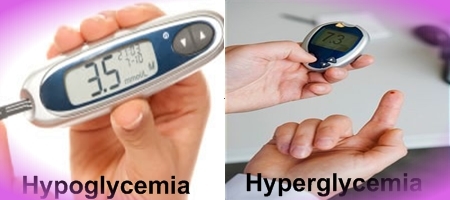Difference between Hypoglycemia and Hyperglycemia

The body metabolizes food stuff that we eat daily and produces energy for daily activities. Food is taken by mouth, broken down into small pieces by GIT and energy is derived from food in the form of glucose, and this glucose is transferred to cell and organ of the bodies. A constant blood glucose level is necessary for physical work; otherwise, a person can have complications like a person can get faint or collapse, cramps or convulsions or can even lead to death when not treated on time. Blood glucose level has got two phases in the body. One is called ‘fasting blood glucose level’ which is the level of blood sugar without having meals. Second is called ‘random glucose level’ and is described as blood glucose level after having meals.
Hypoglycemia
The average level of glucose during fasting condition is about 126mg/decilitre. The concentration of glucose in the blood is less than 70 mg per dl is labelled as hypoglycemia. It is usually uncommon in people without diabetes and frequently seen in diabetic patients being treated with insulin other causes includes prolonged fasting, mal-absorption due to GIT diseases, pituitary insufficiency, patients with renal and liver failure. It can be diagnosed clinically through symptoms like confusion, pounding heart, trembling, hunger, sweating and nervousness. But the only distinctive approach is to check blood sugar level-so that if present, it can be treated immediately as it can be fatal, leading to death. People who are prone to develop hypoglycemia are diabetic patients mainly, but anyone can suffer from this metabolic complication. When hypoglycemia develops in non-diabetic people, it is called as “spontaneous” hypoglycemia. Majority of people are unaware of hypoglycemia, its symptoms and treatment so public awareness should be encouraged in this regard.
Hyperglycemia
Hyperglycemia is characterized by a fasting blood sugar level of more than 126 mg per dL and random blood glucose level of more than 200 mg per dL. Pathological reason of high blood glucose level is either deficiency of or total absence of insulin in the blood, which is most likely seen in diabetes mellitus. As with hypoglycemia, diabetic patients are more liable to develop hyperglycemia, especially if they miss their dose of antihyperglycemic drugs or insulin.
Hypoglycemia VS Hyperglycemia
Definition:
Hypoglycemia is a blood glucose level of less than 70 mg per dL.
Hyperglycemia is the blood glucose level of more than 126 mg per dL.
Cause:
Hypoglycemia can occur in the presence of an excess of insulin seen in patients undergoing treatment of diabetes, missed meals, strenuous exercise, patients with renal or liver failure and GIT disturbances
Hyperglycemia can occur in the absence of insulin or too much food intake, during pregnancy, infection or any other critical illness
Onset:
Hypoglycemia is sudden in onset.
Hyperglycemia develops gradually over a long period.
Signs and symptoms:
A hypoglycemic patient has pale skin, cold body, high pulse, sweating, confused state of mind and maybe convulsions.
A hyperglycemic patient has hot and dry skin, high volume rapid pulse rate, headache, weakness, blurred vision, increased thirst, frequent urination, pain in the abdomen with nausea and vomiting.
Short term complications
Hypoglycemia can cause confusion, fits and tremors.
Hyperglycemia can cause excess urinary excretion, coma and unconsciousness.
Long term complications:
Hypoglycemia damages eyes and kidneys in the long term, causing retinopathy and nephropathy, respectively.
Hyperglycemia causes complications in conception, nerves damage, pregnancy complications, impotence and can cause diabetic ketoacidosis.
What is Diabetic Ketoacidosis?
When there’s insufficient insulin in the body or the cells, do not respond, which doesn’t let glucose to access to the cells, which in result causes the body to utilize fats for energy. As a result, the body produces ketones from breaking down fats. The body cannot handle a high level of ketones, and while it gets rid of the urine. Eventually, ketones build up in the blood, making the blood too acidic.
Treatment:
Hypoglycemia is treated through an infusion of dextrose water.
Hyperglycemia is treated through insulin administration.
Conclusion
Hypoglycemia and hyperglycemia occur due to imbalance in blood glucose level and need urgent treatment. All the cautions should be taken to prevent from these diseases.What is your opinion?


yess ur right and it very important for humain